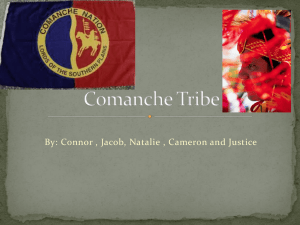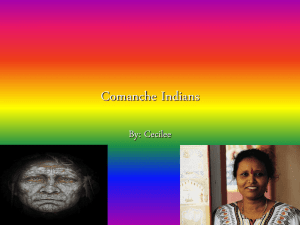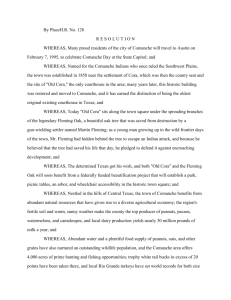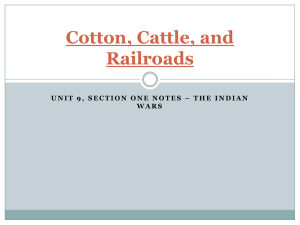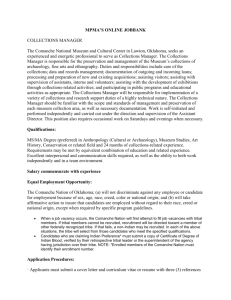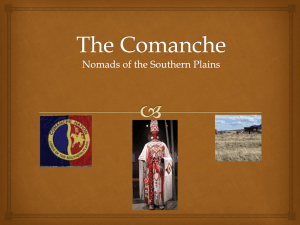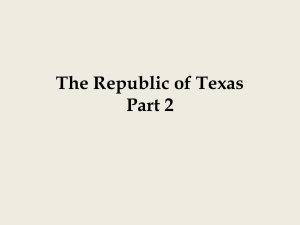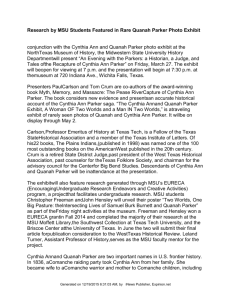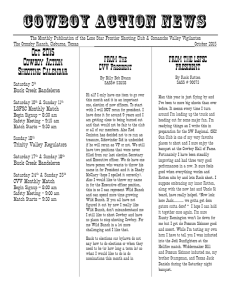empire of the summer moon - La Salle College High School
advertisement
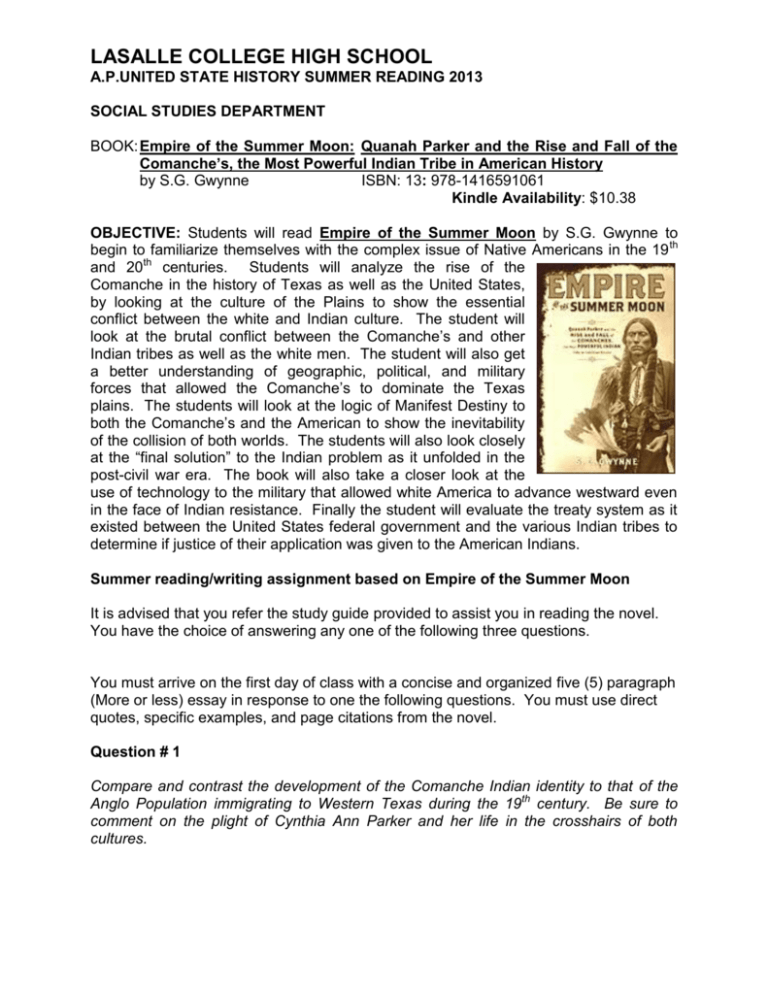
LASALLE COLLEGE HIGH SCHOOL
A.P.UNITED STATE HISTORY SUMMER READING 2013
SOCIAL STUDIES DEPARTMENT
BOOK: Empire of the Summer Moon: Quanah Parker and the Rise and Fall of the
Comanche’s, the Most Powerful Indian Tribe in American History
by S.G. Gwynne
ISBN: 13: 978-1416591061
Kindle Availability: $10.38
OBJECTIVE: Students will read Empire of the Summer Moon by S.G. Gwynne to
begin to familiarize themselves with the complex issue of Native Americans in the 19 th
and 20th centuries. Students will analyze the rise of the
Comanche in the history of Texas as well as the United States,
by looking at the culture of the Plains to show the essential
conflict between the white and Indian culture. The student will
look at the brutal conflict between the Comanche’s and other
Indian tribes as well as the white men. The student will also get
a better understanding of geographic, political, and military
forces that allowed the Comanche’s to dominate the Texas
plains. The students will look at the logic of Manifest Destiny to
both the Comanche’s and the American to show the inevitability
of the collision of both worlds. The students will also look closely
at the “final solution” to the Indian problem as it unfolded in the
post-civil war era. The book will also take a closer look at the
use of technology to the military that allowed white America to advance westward even
in the face of Indian resistance. Finally the student will evaluate the treaty system as it
existed between the United States federal government and the various Indian tribes to
determine if justice of their application was given to the American Indians.
Summer reading/writing assignment based on Empire of the Summer Moon
It is advised that you refer the study guide provided to assist you in reading the novel.
You have the choice of answering any one of the following three questions.
You must arrive on the first day of class with a concise and organized five (5) paragraph
(More or less) essay in response to one the following questions. You must use direct
quotes, specific examples, and page citations from the novel.
Question # 1
Compare and contrast the development of the Comanche Indian identity to that of the
Anglo Population immigrating to Western Texas during the 19th century. Be sure to
comment on the plight of Cynthia Ann Parker and her life in the crosshairs of both
cultures.
Question # 2
F. Scott Fitzgerald once suggested that ‘there are no second acts in American lives’.
Quanah Parker’s life serves as an exception to that rule as it was completely changed
after the final capture of his Comanche band in June 1875. This end to the wild life of
the Comanche’s was merely the beginning of something very new and very different.
He would spend the rest of his life remaking and reinventing himself as a prosperous,
tax-paying citizen of the United States of America who dressed in wool suits and
Stetson hats, attended school board meetings and hosted dinner parties with the
President of the United States….all the while looking out for the Comanche Nation as a
father.
The notion that a late Stone Age barbarian would move into the mainstream of industrial
American culture was just short of ridiculous. A half-breed Comanche warrior of jawdropping aggressiveness, Parker was to become a bourgeois statesman, a prosperous
burgher, a religious leader and businessman who played the game of capitalism as well
as anyone in Texas. Quanah never looked back.
How did this happen?
Identify 3 personal characteristics and 3 specific actions which allowed Quanah Parker
to transform himself from a wild warrior and become the most successful and influential
Native American of the late 19th century.
Question #3
The defeat of the Spanish at the hands of the Comanche’s ‘changed the history of the
West and the fate of North America forever.
The year 1836 was the most ‘tumultuous and transformative’ year in the history of
Texas.
The date October 3rd, 1871 marked the ‘beginning of the ‘final solution’ for American
Indians.
Explain and connect these 3 watersheds in Texas and American History. How they all
are related to the rise and fall of the Comanche’s – the most powerful Indian tribe in
American History.
The following is your READING GUIDE to the book Empire of the Summer Moon.
EMPIRE OF THE SUMMER MOON
Chapter One
A New Kind of War
1. October 3, 1871 marked the ‘beginning of the end of the Indian Wars in American
History 250 years of bloody combat a ‘final solution’ had begun. Explain the
meaning of this ‘final solution’?
2. Locate and describe the geography of Coronado’s Llano Estacado. In what
way was it the ‘edge of the universe for white men?
3. Why were US troops going into this territory, populated exclusively by the most
hostile Indians on the American Continent? Who was their leader? In what way
was he President Grant’s ‘agent of destruction’? Why did he become an
‘agent of retribution’?
4. Describe the ‘hostiles’ of the Great Plains. Who were the Comanche’s? What
was ‘special’ about them?
5. “If the Indian marauders are not punished, the whole country seems in a fair way
of becoming totally depopulated.” In what way were the Comanche’s ‘rolling
back civilization’ both American and Spanish?
6. What was the importance of the Salt Creek Massacre? What did it demonstrate
about the methods and determination of the Comanche’s?
7. ‘Hundreds of {North American} tribes had either perished from the earth or had
been driven west. Trace some of these examples. How was the history of the
Comanche’s different?
8. Describe the extent of ‘greatest mass destruction of warm blooded animals in
human history’ as it relates to the American buffalo.
9. Describe the band of Comanche’s known as the “Quahadis’. What made them
unique among the other hostile Plains Indians? In what way was their land ‘like a
bad hallucination’ to Europeans?
10. Describe the character and personal history of the young war chief of the
Quahadis named Quanah.
11. Who was Cynthia Ann Parker?
12. What is the ‘Battle of Blanco Canyon’? How did it start?
13. Describe the meaning of the title of this chapter.
Chapter Two
A Lethal Paradise
1. Why is the year 1836 the ‘tumultuous and transformative’ year in the history of
Texas? Trace the birth of the sovereign nation called the Republic of Texas.
2. What was Parker’s Fort? Why was it ‘an extremely dangerous place’?
3. Describe how the raid on Parker’s Fort triggered the longest and most brutal of
all wars between Americans and a single Indian tribe?
4. What was the outcome of the raid? In what way did this raid typify the tactics
and methods of the Comanche’s?
5. Reconstruct the ‘logic of Comanche raids’? Why were they so ‘depraved’ and
brutal? Did they reserve this brutality only for white men?
6. If the Parker’s knew about the brutality of the Comanche’s, why did they settle
where they did…’in a place where almost every waking moment held a mortal
threat”?
7. Describe the ‘breed’ of men and women who pushed American civilization
westward into Texas. How was their method different than the spread of the
Spanish Empire?
8. What was the typical attitude of these agents of civilization toward Indians? In
what way was Quanah Parker’s family a nearly perfect example of this attitude?
Explain the irony!
9. Describe the treatment of the survivors of the Parker’s Fort Raid. What became
of Cynthia Ann and Rachel and 14 month old James Plummer? How do we
know?
10. Describe the meaning of this chapter
Chapter Three
Worlds in Collision
1. Describe the extent and power of the Comanche Empire. How is language a
significant sign of their domination?
2. Given the extent of this empire, how is it possible that Anglo-Americans knew so
little about the Comanche’s?
3. Explain the motive for the Mexican encouragement of Americans to settle in
Texas in the 1820’s. What is so ironic about this?
4. Identify early contact between Americans and Comanche’s. In what way was the
Comanche territory as ‘unknown as unexplored regions of Africa’.
5. What is the significance of the fact that the Comanche’s who raided Parker’s fort
were mounted?
6. Describe the early Comanche culture. What happened to transform the
Nermernuh people from such a backward tribe of Stone Age hunters to one of
the most powerful forces of civilization on the North American continent?
7. Describe the nature of the ‘horse revolution’ from the arrival of the Spanish
conquistadors in Mexico with their Iberian mustang, the transmission of Spanish
horse culture and the dispersal of the horses in herds throughout North America.
8. What was the importance of the great Pueblo Revolt of 1680 in terms of the
Great Horse Dispersal? How did this event alter the power structure of the
Great Plains. What role did the Apaches play in this change?
9. How did horse technology change the method of hunting and war making?
10. “I am ready, without hesitation, to pronounce the Comanche’s the most
extraordinary horsemen I have seen yet in all my travels ...The finest light cavalry
in the world.” What additions to “horse technology” did the Comanche’s
create?
11. “No other tribe, except possibly the Kiowas, so completely lived on horseback
from their ‘horse vocabulary’ ...to gambling.” Explain
12. In what way did the Comanche mastery of the horse lead to their migration
southward? Why was this important in the competition for buffalo?
13. When and where did the Comanche ride into recorded history?
14. Explain the meaning of the title of this chapter?
Chapter Four
High Lonesome
1. “With these remarks, I submit the following pages to the perusal of a generous
public; feeling assured that before they are published, the hand that penned them
will be cold in death.”
Briefly describe the memoir of captivity of Rachel Plummer Parker.
2. Describe and locate the heart of the Comancheria, otherwise known as the
Great American Desert. In what ways was it ‘incomprehensible’ and ‘alien’
‘oceanic’ and terrifying to “white Americans?”
Why was this the last part of the country to be settled?
3. Describe the ‘least hospitable’ climate of this territory. Describe a ‘norther’; a
blue norther’; a blizzard; a whiteout.
4. Describe the logic of kidnapping Rachel Plummer in terms of the buffalo
economy. What were the ‘value- added’ chores which the women performed?
5. “My little innocent baby was not only dead, but literally torn to pieces.”
Based on the buffalo economy, why was it important for men to become
polygamous? Why was it important to have slaves such as Rachel? Why was
her seven week old baby strangled?
6. “Torture killing by committee; gang rape; scalping; cutting out tongues; burning
alive; dancing in glee as bodies worked as worms and burst in fire.”
Explain the moral algebra involved in the behavior of the Comanche’s? What
does the author mean when he says that ‘Crazy Horse is free to be the hero we
want him to be’?
7. “If the Comanche’s were implacable killers, grim apostles of darkness and
devastation, inside their camps they were something entirely different… To
others they were the personification of death. To themselves, they were simply
‘People’. Explain?
8. In what ways was the culture of all Plains Indians built around the buffalo?
9. Describe the social structure of the Plains Indians. What was the difference
between the white man’s conception of a ‘tribe’ and the Comanche ‘band’? Why
was it a mistake to make a treaty or understanding with a ‘band headman’?
10. Identify the five major ‘bands’ of Plains Indians at the turn of the 19 th century.
11. “The Comanche’s were ‘without a center’. Explain the political leadership of the
band?
12. What became of Rachel?
Chapter Five
The Wolf’s Howl
1. Explain how the defeat of the Spanish at the hands of the Comanche’s ‘changed
the history of the West and the fate of North America.
2. Describe the economic system known as encomienda. Did it succeed?
3. Explain how the Apaches applied ‘guerilla warfare’ upon the Spanish in New
Mexico.
4. Describe the extent of Apacheria in human and geographical terms.
became of the Apaches between 1706 and 1748?
What
5. Describe the methods used by the Comanche’s against the Spanish as well as
other Indian tribes. How did this method transform the Comanche’s into a
Spartan- like society by 1750?
6. Identify the ‘Comanche barrier’. What purpose did it serve?
7. ‘The story of Colonel Don Diego Ortiz de Parrilla offers one of history’s clearest
windows into what it was like in Comanche tormented New Spain. Describe the
San Saba Massacre of 1758.
Why was it the gravest of miscalculations by the Spanish? What role did the
Apaches play in this affair?
8. Describe the Texas ‘summer moon’?
Comanche’s?
What was it significance to the
9. What revenge did Parrilla take against the Tonkawas? What was the Comanche
reaction at Spanish Fort? What became of Parrilla and the future of the Spanish
Empire?
10. Describe the methods and attitude toward handling of the “Comanche problem”
employed by Gov. Don Juan Bautista Anza. How did he propose to deal with
Chief Cuerno Verde ‘the scourge of the kingdom”? Did it work?
Chapter Six
Blood and Smoke
1. “Mirabeau Buonaparte Lamar was a poet, a superb horseman, an amateur
historian, oil painter, and President of the Republic of Texas in 1839. But above
all, even by frontier standards he was a dangerous, mean and uncompromising
son of a bitch.”
Describe Lamar’s attitudes toward Indians and his policy to carry it out.
2. Describe Lamar’s expedition against Chief Bowles and the Cherokees in 1839.
How did this initial expedition expand into the clearing out of the ‘rat’s nest’ and
become ‘last stop on the trail of tears” for thousands of Indians. What was the
motive of the Texans?
3. What was the purpose and meaning of the raid by Colonel John Moore in
February,. 1839 upon Comanche’s? Did it succeed?
4. Describe the ‘peace negotiations’ between Comanche’s and Texans at Council
House. What role did Maltilda Lockhart play?
5. What was the significance for the future relations of Texans and Comanche’s as
a result of the Council House fight?
Chapter Seven
Dream Visions and Apocalypse
1. Who was Buffalo Hump? What was his Nermernuh name? What did it literally
mean?
2. Describe Buffalo Hump’s vision and explain how he carried it out at the Great
Linville Raid in August, 1840.
3. “They were drawn to the West by the adventure, violence and glory. Fearless 24
year olds with a distinct taste for combat. “Define the characteristics of the
Texans who fought against Buffalo Hump.
4. How did the Battle of Plum Creek change the style of white resistance to the
Comanche’s, led by John Coffee Hays? Was this battle a victory for the Texans
or for the Comanche’s?
5. What happened when the battle was over?
Chapter Eight
White Squaws
1. Identify the ‘three keys’ in which history is played (written). In which key is the
story of Cynthia Ann Parker? Explain. Why is there no Indian ‘history’ of her
existence?
2. What is a ‘loved captive’? Recount the story of Bianca ‘Banc’ Babb. Why is it
important in the history of White Squaw?
3. Who is Leonard H. Williams? What is the significance of his ‘story’ about White
Squaw? What did he learn about her that other whites would not/could not
accept?
4. Who were the Penatekas? How are they important in the history of Cynthia Ann
Parker? What became of their culture? Why?
5. Explain the degree and extent of ‘white man’s diseases’, particularly cholera in
1849? Where did it come from? What was the effect on the Plains Indians?
How did the People (Nermernuh) deal with such diseases?
6. Why does the author say that peace in Texas at mid-century was an “illusion”?
Show how the Treaty of 1844, engineered by Sam Houston, an old Indian man,
illustrates just how deeply whites misunderstood the Comanche’s.
7. Who was the son of Cythania Ann Parker and her Comanche husband Peta
Nocona? Where did his name come from? Why is he so important to the history
of the Comanche’s?
Chapter Nine
Chasing the Wind
1. Who was James Parker and what was his importance to the history of Cynthia
Ann Parker?
2. Describe the term ‘Comanchero’. What was their heritage? What was their
relationship to the Comanche’s?
3. Reconstruct the story of the other captive from the Fort Parker Raid, Rachel
Parker Plummer. How did she eventually die? What was so ironic about the
cause of her death?
4. What became of James Parker? Did he succeed in his ‘quest’?
5. Explain the meaning of the title of this chapter?
Chapter Ten
Deaths of Innocent Face
1. Compare the Treaty of Guadalupe Hidalgo, in February 1848 to the Treaty of
Appomattox Courthouse in April 1865. What purpose did each in its own way
serve in U.S. History?
2. How did the Treaty of Guadalupe ‘change everything in the West? In what way
was it “Manifest Destiny made manifest’?
3. Trace the geography of the Oregon Trail and the Santa Fe Trail. What purpose
did each serve in the expansion of white Americans across the continent? Why
did none of the travelers on these highways stop to make settlements?
4. What effect did the Treaty of Guadalupe and this expansion have on the
Comanche’s? What was the importance of the 1849 Gold Rush in this same
regard?
5. ‘But these land-grabbers, sodbusters and Pilgrims were not the only or gravest
threat to the Comanche’s. That came in the form of dirty, bearded, violent, and
undisciplined men wearing buckskin, serapes, coonskins and sombreros who
belonged to no Army, wore no uniforms and were only intermittently paid.”
Who were these men?
6. Briefly trace the history of the Republic of Texas from 1838 to its incorporation
into US statehood. Why was Texas ‘left alone for that 10 year period with two
implacable enemies neither willing to surrender and one that did not even have
that word in their vocabulary?” Explain
7. Compare the relative advantages of the Texans and the Comanche’s in regards
to their military technology and tactics.
8. “War was what they did and their social status depended on it reckless, single
men with a taste for wide open spaces and raw adventure never looking for
something other than a sedentary life.”
Compare the attitudes toward military adventure and the “inclination to kill’ of
both the Texans and the Comanche’s. How were they similar and how were they
different from each other?
9. ‘The Rangers were a tough bunch brigands and desperados. Not someone you
wanted to pick a fight with in a frontier saloon. How did the ‘Texas Rangers’
come into existence? How were they different than the Texas militia?
10. Who was John Coffee Hays and why was he known as the ‘uber-Ranger’? How
can he be compared to US Grant? How were his rangers – the Hays Rangersdifferent than those Texas Indian fighters who preceded them? What military
tactics did they borrow from the Comanche’s?
11. Identify the two battles in 1841 which established John Coffee Hays’ fame and
reputation as an Indian fighter. What were his personal characteristics which
made him suited for fighting the Comanche’s?
12. What was the one major disadvantage that confronted the Hays Rangers in
fighting Comanche’s? What technological breakthrough not only solved this
problem but ‘changed the world’?
13. Analyze the strengths and weaknesses of the Samuel Colt revolver.
14. How did the minor Battle of Walker’s Creek come to be the defining moment in
the history of Texas and of the American West? What did the Mexican War do
for the future of this weapon?
15. What improvements did the collaboration of Eli Whitney, Samuel Walker and
Sam Colt make in the original design of the Colt revolver which became known
as the Walker Colt?
Chapter Eleven
War to the Knife
1. Who are Nautdah? Quanah? Peanuts? Prairie Flower? Peta Nocona? How do
we know their story?
2. Who is Isaac Parker? How is he related to Nocona? Explain the irony of this
relationship.
3. Why did Ezra Sherman and his family move to Stagg Prairie? What was the
consequence for his wife Martha?
4. ‘The lingering death of Martha Sherman in the fall of 1860 was the harvest of a
decade of federal incompetence, stupidity, and willful political blindness”.
Describe the nature of this ‘incompetence. In what way was Peta Nocona’s
‘raid’ and brutality a ‘political act”?
5. “They were like something out of Louis XIV’s court the only way Indians could be
in danger from these soldiers was if their appearance and horsemanship caused
Indians to laugh themselves to death.”
Describe the ‘new Indian fighters’ (dragoons) who were sent to the Texas
frontier? What was their ‘problem (s)’?
6. Describe the “treaty system” as it existed between the federal government and
the Indians of the Plains. What were the common outcomes of most every treaty
signed between Indians and the government?
7. How did Manifest Destiny as a ‘notion and a blueprint’ influence the treatment of
Indians?
8. Describe Jefferson Davis’ Brazos River ‘reservation’ plan in 1855 for the
Penatekas (Comanche) why did it fail? What did the white settlers of Texas have
to do with this failure?
9. Why is John Salmon “Rip’ Ford known as one of the West’s most remarkable
characters.
10. What role did the 1857 “Mormon Revolt’ play in fanning the flames of Indian
warfare?
11. What was the importance of the Battle of Antelope Hills in Texas History?
12. Why did the success of Ford’s raid motivate the US Second Cavalry led by Earl
Van Dorn, to move back from Utah? Who was Sul Ross?
13. What was the importance of the Battle of the Wichita Village?
Chapter Twelve
White Queen of the Comanche’s
1. Why is the brief Battle of Pease River considered a major historical event- indeed
(falsely) as the major turning point in the war against the Comanche’s and in
Texas history? -Why is this “false history”?
2. “She had forsaken the virtues of Christianity for the wanton immorality of the
Indian. That was the attraction Texans could not get enough of her.”
Describe the ‘freak show’ in which Cynthia Ann Parker was put on display after
her capture by Sul Ross at the Battle of Pease River.
3. Describe the difficult process of Cynthia’s ‘repatriation’. “Things did not go
well…she continued to be disconsolate. She wept; she tried to escape; she
refused to cooperate.
4. Who was Cho Smith and how was his description of Cynthia different than most
others?
5. .Describe the photograph of Cynthia and Prairie Flower. Why is so special to the
point that there never was a precedent for it on the entire Texas frontier? What
does it say about the white racial attitudes towards Indians?
6. What effect did the death of Prairie Flower have on her ‘adjustment’ process?
Was she ever able to re-claim her previous life as a white woman?
7. Describe the circumstances surrounding Cynthia Ann’s death? In what way was
she a ‘relic of ‘old Comancheria”?
Chapter Thirteen
The Rise of Quanah
1. How did come to be that Quanah survived the Battle of Pease River? Why is the
Comanche version of this battle different from the white’s? In what way was it
considered as a ’stain’ on Nocona’s record?
2. Describe the male dominated culture in which Quanah grew up as a young boy.
How did this life of personal freedom and happiness change with puberty?
3. Describe the ‘vision quest’ that transformed boys to men.
4. Paint a mental portrait of how Quanah looked. In what way were his looks a
‘model of what white people thought a noble savage ought to look like?
5. How did the Battle of Pease River change Quanah outlook on life, especially his
feelings toward white people? Explain the purely political motive in Comanche
raids led by Quanah.
6. Describe in a few examples how Quanah’s conspicuous bravery on the battlefield
led him to become at a very young age one of the select men who would lead the
final military expeditions of the Comanche people.
7. In what way was the story of Quanah’s marriage the most dramatic of his early
life?
Chapter Fourteen
Uncivil Wars
1. How did the Civil War affect events within the Comancheria? What does the
author mean by the ‘demon of neglect’?
2. Identify the Indian Removal Act of 1830? What effect did this have on Indian on
Indian relationships?
3. Describe the violence between ‘Confederate Indians’ and ‘Union Indians”.
How did the Civil War present many opportunities to ‘settle old scores’?
4. Describe the Santee Sioux uprising in 1862 which was the largest single civilian
wartime death toll in US history prior to 9/11 and the largest one day execution in
American History.
5. ‘Manifest Destiny only worked if you could conquer and subdue the nation’s
midsection, the Santa Fe Trail was shut down. Emigration stopped, canceling
two decades of westward progress.” In what did the ‘frontier roll backward’ by as
much as 200 miles after 1863? Why?
6. Describe the Elm Creek Raid as an example of this new ‘untrammeled violence’
of this period.
7. What were the consequences of the Indian Removal Act of 1830?
8. Identify Kit Carson and explain how he became one of the most “storied figures
in US History”.
9. Explain how the Howitzer(‘the gun that shot twice’) was used to blast the adobe
walls of the Kiowas in the largest single battle ever fought on the Great Plains
In what way was the official report of this ‘Battle of the Adobe Walls’ noteworthy
for its complete inaccuracy?
10. Damn any man who sympathizes with Indians. I believe it is right and honorable
to use any means under God’s heaven to kill Indians.” -Identify JM Chivington
and explain how he came to preside over the ‘bloodiest, most treacherous and
least justified slaughter in American History one that would pass into legend and
infamy” on November 28th, 1864 at Sand Creek, Colorado.
11. What effect did the Sand Creek massacre have on the future of Indian Policy?
Chapter Fifteen
Peace and Other Horrors
1. Explain the controversy between the army and the ‘rosewater dreamers from the
Indian Office over the issue of how best to treat Indians and achieve peace.
2. In what way were both sides of the controversy based on a lack of historical
understanding of the Comanche’s?
3. Describe the causes and consequences of the ‘peace’ conference held at
Medicine Lodge Creek in October 1867. Using direct quotes from Satanta
and Ten Bears, what exactly did the Plains Indians want from their white
adversaries? Was this possible?
4. ‘You can no more stop this than you can stop the sun or the moon. You must
submit and do the best you can.” Explain General Sherman’s ‘solution’ to the
Indian problem.
5. Explain the meaning of the title of this chapter in terms of the consequences of
the great Treaty at Medicine Lodge in 1867.
6. Explain the new peace policy known as the Quaker Plan, brought forward by
President Grant. How was it different from the old?
Chapter Sixteen
The Anti-Custer
1. Who was Colonel Ronald Slidell Mackenzie and what role did he play in the
Indian Wars. How did he become entangled in the life of Quanah?
2. In what way was Mackenzie the ‘anti-Custer’?
3. Describe the Spencer rifle and its importance in the ongoing Indian Wars.
4. In what way was Mackenzie’s ‘failure at Blanco Canyon ‘a missed opportunity to
end the siege of the most violent Comanche band on all of Texas?
Chapter Seventeen
Mackenzie Unbound
1. Despite the fact that Mackenzie failed to subdue Quanah and the Quahadis at
Blanco Canyon in 1872, this marked the ‘beginning of the end of the old empire.
Explain
2. Compare the violence and terror of the phase of the Indian Wars from 18501872 to the trench warfare of WWI. In what was Mackenzie the right man to
bring this terror to a stop?
3. Why was the Battle of the North Fork of the Red River (McClellan Creek) such
a ‘shattering experience’ for the ‘People’?
Chapter Eighteen
The Hide Men and the Messiah
1. Identify the ‘Buffalo men’ and explain why they were the greatest threat to the
existence of the Comanche’s between 1868 and 1881. Who were the ‘hide men’
and what was their business?
2. ‘Killing the [buffalo} was not just an accident of commerce; it was a deliberate
political act’ which had no precedent in human history.’ Explain
3. Identify Billy Dixon, Bat Masterson, Dutch Henry, and James ‘Bermuda’ Carlyle
4. Who was Isa-tai? What does his name mean? What was his relationship to
Quanah? What role did he play in uniting the Comanche bands? Why is he
known as the ‘Messiah’?
5. Describe the Sun Dance and analyze its role in the large scale revenge raids
against white men in Texas.
6. Describe the appearance of Isa-tai in Yellow at the start of the raid on the
trading post at Adobe Walls? What effect did the Sharps ‘Big Fifties’ buffalo
guns have on the outcome of the battle?
7. Why did the Texas frontier ‘fort up’ as a result of the summer raids of 1874
known as the Second Battle of Adobe Walls by Quanah and Isa-tai? How did
President Grant react?
8. . What does the author mean when he refers to President Grant as an ’uberwarrior’?
Chapter Nineteen
The Red River War
1. Describe the status of the Comanche’s by the summer of 1874. Where did they
now live?
2. Explain the concept of ‘guerilla warfare’ as it relates to the hostilities on the
Texas frontier by 1874. Why was the Texas the Texas Panhandle the best place
for the Comanche’s to camp?
3. Describe the force that took the field against the Comanche’s in the Red river
campaign led by Col McKenzie. -In what ways was this the battle of the ‘last
frontier’? What did that mean for white America?
4. What was the ‘sanctum sanctorum’ of Comancheria? Where was it located?
Why was this important as the field of battle?
5. Explain the ‘deep cultural contamination’ that was found in the ‘jaws of death’ in
what came to be known as the Battle of Palo Duro Canyon.
6. Describe the grotesque monument which came to mark the end of the
‘dominion of the horse tribes on the American plains. What was the legend
that was spawned by the brutality of this single act?
7. What was the terrible new reality faced by the Comanche’s after this battle?
What was the status of the remaining Indians?
8. Describe last band of Comanche’s not to surrender known as Quanah’s
Quahadis. How was it that they survived the onslaught by McKenzie
9. What was the surprising change of heart that Quanah preached to his band after
being found at Ft Sill in May 1875? Who was this man and why was his
announcement such a shock? What forces influenced him to arrive at this
decision?
10. Describe the trip to Ft. Sill by Quanah and his band. In what way was it the ‘last
rites of freedom’? Why did the ’People’ offer no resistance?
11. Describe the remarkable and unlikely relationship that was struck between
Quanah and Mackenzie. In what way was this friendship based upon a letter
which was discovered and published in a Dallas newspaper in May 1875?
Chapter Twenty
Forward in Defeat
1. “No way out; no way back” Describe the life on the reservation from the
Comanche perspective. Were there any ‘charitable’ contributions offered to them
by the white men of Texas? In what way did this strange new world of
reservation life become the ‘staging ground’ of the career of Quanah Parker?
2. “The notion that a late Stone Age barbarian would and could move resolutely into
the mainstream industrial American culture and become a bourgeois. Describe
the way in which Parker remade himself and the entire Comanche nation with
him. Why was the rise and remake of Quanah Parker so strange given his
history?
4. What insight did Quanah gain immediately about the ‘way to power’?
5. How did Quanah use his instinctive skills as a warrior chief to lead his people on
the reservation in a manner much like a ‘Chicago ward boss’ who learned to
use the ‘politics of the reservation’?
6. Describe the special mission which MacKenzie assigned to Quanah. How did
he succeed in this mission?
7. Analyze the characteristics of Quanah’s unique personality and how it allowed
him to advance himself and his people.
8. .Describe the ‘last buffalo hunt’ in 1878 which the Comanche’s and Kiowas
engaged in. What did they find as they entered the hunting fields?
9. Describe the unique and historic ‘treaty’ made between Charles Goodnight
and Quanah Parker.
10. Who were the ‘buffalo soldiers’? What was the importance of their
confrontation with Quanah and Goodnight?
11. Describe the role that the cattle business played in changing Quanah’s life.
What was the importance of the ‘Western trail’? How did the ‘protection
racket’ work to the advantage of the Comanche’s
12. What was meant by ‘grass money’ and how did this work to the advantage of
Quanah and the Comanche’s? Why did no one ever cheat Quanah at the
business/game of leasing land?
13. What was the Ghost Dance Cult? How did this occurrence figure into the
growing power of Quanah?
14. What was the nature of Quanah’s own personal business? Describe the
Quanah Pasture’?
15. Explain the importance of the book published in 1886 by James DeShields
about Quanah. What was the image which his work portrayed? Why did he
refuse to get rid of his 8 surplus wives’? How did this come back to haunt him?
16. Describe his ‘crowning glory’ the Star House which he built for himself.
Describe the ‘ploy ‘which he concocted to get enough money to finance the
building of his house. How is this story so revelatory of the man he was?
17. Describe Quanah’s family. How many children did he father? How many
children were white? What was the single most important thing which gave
meaning to Quanah’s life? Describe the many guests that came to the Star
House. How did Quanah’s new life and new persona belie F. Scott Fitzgerald’s
dictum that there are no second acts in American Life?
18. What became of McKenzie?
Chapter Twenty-One
This was a Man
1. Describe the purpose and consequence of the Jerome Commission of 1889?
How did Quanah respond to this proposal?
2. How did the final agreement with Congress in 1900 allow the Comanche’s to
become land owners?
3. Describe the events of 1908 and how they illustrated the distance that Quanah
came from his days since his birth on the prairie.
4. Analyze Quanah’s relationship with Teddy Roosevelt.
5. How did Quanah become one of the leading religious figures in the Comanche
tribe and the Plains Indians? In what way was the ‘peyote religion’ one of the
most important cultural contributions of the Comanche’s to the lives of other
American Indians?
6. What troubles entered into Quanah’s later life? How was Quanah’s life different
form his more famous neighbor Geronimo? What is the ironic address of
Geronimo’s burial place?
7. If ever nature stamped a man with the seal of headship, she did it in his
(Quanah’s) case. He might have been a leader and a governor in any circle
where fate might have cast him. Even those who were restive under his rule
recognize his supremacy .He had his followers under wonderful control, but, {he}
looks out for them like a father.”
Apply this personal description by Indian Agent Francis Leupp to Quanah’s
actions. What were his personal characteristics and traits that warranted such
praise?
Chapter Twenty-Two
Resting Here Until Day Breaks
1. What became of Quanah’s Mother, Cynthia Anne Parker? -What were
Quanah’s words recited at her grave?
2. What were Quanah’s last comments delivered at the Quanah Route Day
celebration at the Texas State fair on October 25th 1910? According to the
author, what was the message underlying his remarks that day?
3. What were the circumstances of his death? Where was he buried?
4. What became of the Comancharia, The Lords of the South Plains?
5. Identify the inscription on his gravestone. Would Quanah have been pleased to
have read it?
